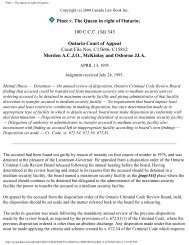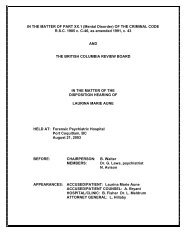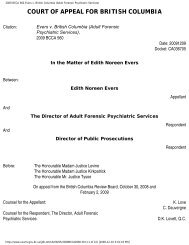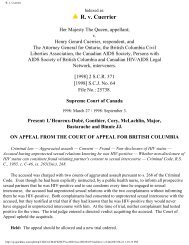R. v. CONWAY - British Columbia Review Board
R. v. CONWAY - British Columbia Review Board
R. v. CONWAY - British Columbia Review Board
Create successful ePaper yourself
Turn your PDF publications into a flip-book with our unique Google optimized e-Paper software.
Charter. Again, only the third step of the Mills test was considered, and again the tension on display<br />
in Weber and Mooring was exhibited. McLachlin C.J., for the majority, reiterated the principles set<br />
out in Dunedin and explained that in all cases the question is<br />
whether Parliament or the legislature intended to empower the court or tribunal to make<br />
rulings on Charter violations that arise incidentally to their proceedings, and to grant<br />
the remedy sought as a remedy for such violations. [para. 26]<br />
She went on to conclude that a preliminary inquiry court was not a court of competent jurisdiction<br />
for the purpose of excluding evidence under s. 24(2). A preliminary inquiry’s primary function was,<br />
in her view, to determine whether the Crown has sufficient evidence to warrant committing the<br />
accused to trial. Empowering a preliminary inquiry judge to exclude evidence under the Charter<br />
would jeopardize the inquiry’s expeditious nature. The criminal trial courts were better suited to<br />
the task of determining whether to exclude evidence.<br />
[39] Major J., writing in dissent for four judges, agreed that only the third step of the<br />
Mills test was at issue but disagreed with the majority as to the result. He noted that preliminary<br />
inquiry judges were authorized to exclude evidence under the common law confessions rule. It was<br />
not, therefore, supportable by “logic or efficiency to permit a preliminary inquiry justice to<br />
determine the admissibility of statements for common law purposes, but not for Charter purposes,<br />
when it is recognized that preliminary inquiry justices are armed with all the facts. Parliament could<br />
not have intended such waste” (para. 96). Accordingly, in his view, a preliminary inquiry judge was<br />
competent to exclude evidence under s. 24(2).<br />
[40] This review of Mills’ progeny gives rise to three observations. First, this Court has



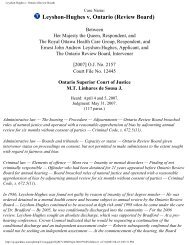
![LaFortune [LaFortunate] (Re) - British Columbia Review Board](https://img.yumpu.com/42779845/1/190x245/lafortune-lafortunate-re-british-columbia-review-board.jpg?quality=85)
